Turn the ignition switch to the ON, and then check that the bulb lights up and the fuel gauge needle moves to full.
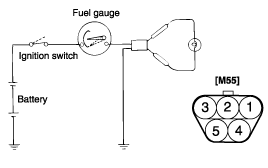
Adjust the pressure of the tires to the specified level.
Drive the vehicle onto a speedometer tester. Use wheel chocks as appropriate.
Check if the speedometer indicator range is within the standard values.
Do not operate the clutch suddenly or increase/ decrease speed rapidlywhile testing.
Tire wear and tire over or under inflation will increase the indicationerror.
Velocity (km/h) | 20 | 40 | 60 | 80 | 100 |
Tolerance (km/h) | 20-24.6 | 40-44 | 60.8-65.4 | 81.4-86.8 | 102.5-108.2 |
Velocity (km/h) | 120 | 140 | 160 | 180 | 200 |
Tolerance (km/h) | 123.5-129.6 | 144.4-151 | 165.4-172.4 | 186.3-193.8 | 207.2-215.2 |
Velocity (MPH) | 10 | 20 | 40 | 60 | 80 | 100 | 120 |
Tolerance (MPH) | 10-12.5 | 20-22.5 | 40-42.6 | 60-63.4 | 80.3-84.1 | 100.3-104.7 | 120.3-125.3 |
Connect the scan tool to the diagnostic link connector or install a tachometer.
With the engine started, compare the readings of the tester with that of the tachometer. Replace the tachometer if the tolerance is exceeded.
Reversing the connections of the tachometer will damage the transistor and diodes inside.
When removing or installing the tachometer, be careful not to drop it or subject it to severe shock.
Revolution (RPM) | 1,000 | 2,000 | 3,000 | 4,000 | 5,000 | 6,000 | 7,000 |
Tolerance (RPM) | ±100 | ±125 | ±150 | ±150 | ±150 | ±180 | ±210 |
OPERATION CHECK
Disconnect the fuel sender connector from the fuel sender.
Connect a 3.4 watt, 12V test bulb to terminals 2 and 3 on the wire harness side connector.
Turn the ignition switch to the ON, and then check that the bulb lights up and the fuel gauge needle moves to full.

Using an ohmmeter, measure the resistance between terminals 2 and 3 at each float level.
Float position | F | 1/2 | E |
Resistance (Ω) | 4.0 | 32.5 | 110 |
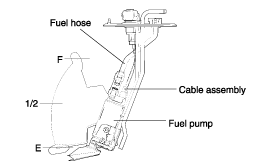
Also check that the resistance changes smoothly when the float is moved from "E" to "F".
Connect a test lamp (12V, 3.4W) and the battery to the sender terminals 1 and 3. Immerse the sender in water.
The lamp should be off while the thermister is submerged in the water, and should illuminate when the sender is taken out of the water.
If there is a malfunction, replace the fuel sender as an assembly.
After completing this test, wipe the sender dry and reinstall it in the fuel tank.
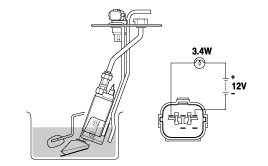
Disconnect the wiring connector from the engine coolant temperature sender in the engine compartment.
Turn the ignition switch ON. Check that the gauge needle indicates cool. Turn the ignition switch OFF.
Connect a 12V, 3.4 watt test bulb between the harness side connector and ground.

Turn the ignition switch ON.
Verify that the test bulb flashes and that the indicator moves to HOT.
Using an ohmmeter, measure the resistance between the terminal 2 and ground.
If the resistance value is not as shown in the table, replace the temperature sender.
Temperature(°C) | 60 | 85 | 110 | 125 |
Resistance(Ω) | 118 | 49.0 | 25.0 | 14.6 |
Check that there is continuity between the switch's terminal and ground with the engine stopped.
Check that there is no continuity between the terminal and ground with the engine running.
If operation is not as specified, replace the switch.
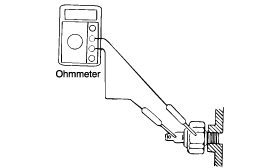
Disconnect the connector from the warning switch and ground the terminal on the wire harness side connector.
Turn the ignition switch ON. Check that the warning lamp lights up. If the warning lamp doesn't light, test the bulb or inspect wire harness.
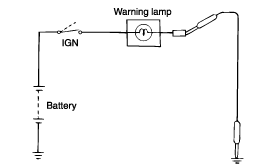
Remove the connector from the switch located at the brake fluid reservoir.
Verify that continuity exists between switch terminals 1 and 2 while pressing down the switch (float) with a rod.
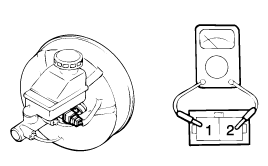
Start the engine.
Release the parking brake.
Remove the connector from the brake fluid level warning switch.
Ground the connector at the harness side.
Verify that the warning lamp lights.
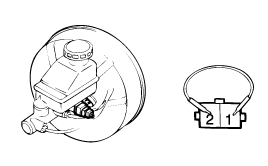
Check that there is continuity between the terminal and switch body with the switch ON (Lever is pulled).
Check that there is no continuity between the terminal and switch bodywith the switch OFF (Lever is released).

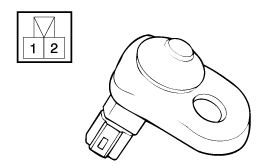

Remove the connector from the switch.
Check for continuity between terminals.
Seat belt condition | Continuity |
Fastened | Non-conductive(∞Ω) |
Not fastened | Conductive (0Ω) |
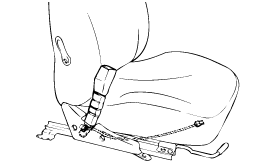
Seat belt condition | Warning lamp |
Fastened | OFF |
Not fastened | ON |